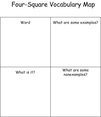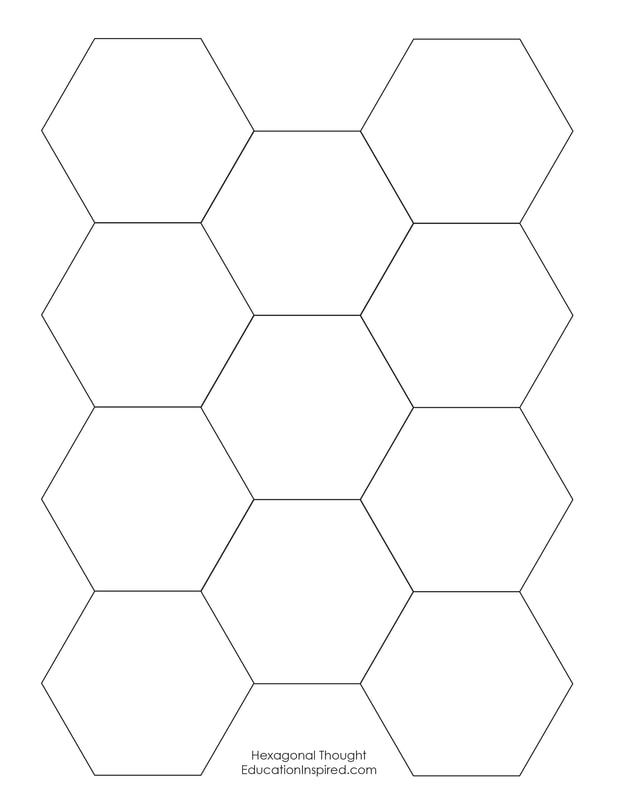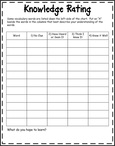Vocabulary Strategies
Students learn the most vocabulary when they read from a wide variety of text. Still, it helpful to directly teach students words, and to teach students how to use context and what they know about words to figure out new words. When teaching vocabulary, be sure to select words that will be used in the students' lives. Special jargon or rare words don't need to be taught directly, since students will not likely use those words in the their real lives. Instead, select words that are common to every day life, or words that are critical for understanding the text being read.
When evaluating strategies or activities for vocabulary instruction, look for strategies that include opportunities for students to make personal connections to the new vocabulary, to have multiple exposure to the vocabulary, and to use the vocabulary in authentic ways. Making connections, having multiple exposures, and using vocabulary in a real way is how students learn words best. All the strategies here are great examples of research-based vocabulary strategies.
When evaluating strategies or activities for vocabulary instruction, look for strategies that include opportunities for students to make personal connections to the new vocabulary, to have multiple exposure to the vocabulary, and to use the vocabulary in authentic ways. Making connections, having multiple exposures, and using vocabulary in a real way is how students learn words best. All the strategies here are great examples of research-based vocabulary strategies.
Click and Clunk: Students use a variety of strategies to come to an understanding of an unknown word.
| |||
Four Square Vocabulary Map: Students critically consider word definitions and relate new words to previously known words.
| |||
Hexagonal Thought: After reading or studying, students make connection between vocabulary words within a unit. There are multiple ways to complete this activity.
A. Distribute blank hexagons to students. Students write one key word they learned during the unit in one hexagon (and cut out the hexagons, if you didn't pre-cut them). Students work together to connect all the hexagons they made. One student sets the hexagon in the middle of the group and describes the word. Then, continuing until every student has included his/her hexagon, students place their own hexagons adjacent to hexagons that have already been put down. Students must identify how the vocabulary words connect to all the adjacent hexagons when they put their own hexagons down.
B. Prepare hexagons in advance by writing one vocabulary word on each one and cut them out. Students collaborate to connect all the hexagons, making connections between each word and every adjacent hexagon.
C. You can modify this activity by using pictures, or by adhering the vocabulary to actual hexagon manipulatives.
A. Distribute blank hexagons to students. Students write one key word they learned during the unit in one hexagon (and cut out the hexagons, if you didn't pre-cut them). Students work together to connect all the hexagons they made. One student sets the hexagon in the middle of the group and describes the word. Then, continuing until every student has included his/her hexagon, students place their own hexagons adjacent to hexagons that have already been put down. Students must identify how the vocabulary words connect to all the adjacent hexagons when they put their own hexagons down.
B. Prepare hexagons in advance by writing one vocabulary word on each one and cut them out. Students collaborate to connect all the hexagons, making connections between each word and every adjacent hexagon.
C. You can modify this activity by using pictures, or by adhering the vocabulary to actual hexagon manipulatives.
The page with 6 hexagons is designed for you to copy, cut into sixths, and distribute to students for them to make their own hexagons (or cut the paper into thirds if you want each student to do 2 hexagons/words).
The page with 11 hexagons is for you to prepare and cut. This design allows you to cut more hexagons with less actual cutting, although the hexagons are smaller. You can easily make your own hexagons your own sizes by adding a shape in a Word document. | |||
I Can Name It In 3: Students use oral language to describe vocabulary words in a new way so that other students can guess the mystery vocabulary by listening to the definitions and descriptions.
| |||
Knowledge Rating: Students activate prior knowledge and set a purpose for reading. This strategy is also useful in determining which vocabulary words need to be taught and which ones students already understand. This strategy can also be done orally. Say a word aloud. Students hold up the number of fingers that corresponds to their level of knowledge.
| |||
Multiple-Meaning Word Map: Students map out multiple meanings of one word.
| |||
Pinch Card: Students practice discriminating between the appropriate use of graphically similar words or homophones.
| |||
Semantic Feature Analysis: Students synthesize information by evaluating new knowledge and making
categorical judgments.
categorical judgments.
| semantic_feature_analysis.pdf |
Vocabulary Book: Students develop understanding of new vocabulary by connecting vocabulary in context with prior knowledge.
| |||
Word Map: Students graphically represent an understanding of new vocabulary by connecting vocabulary and prior knowledge.
| |||
Word Sort: Students develop deep understanding of vocabulary through critical comparison to other words.
| word_sort.pdf |









